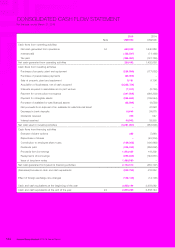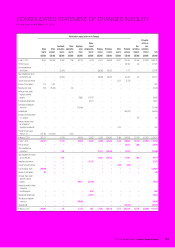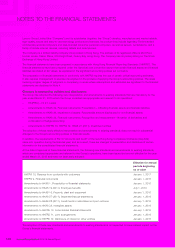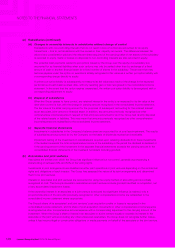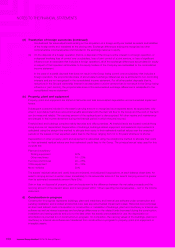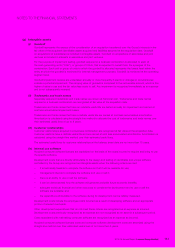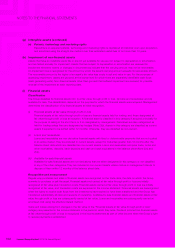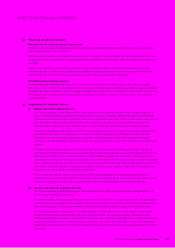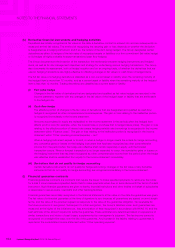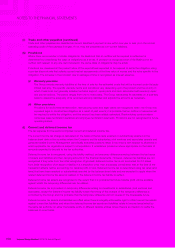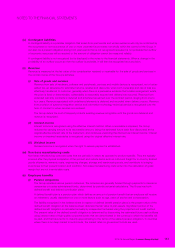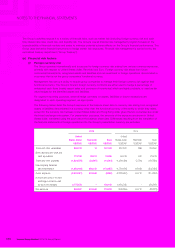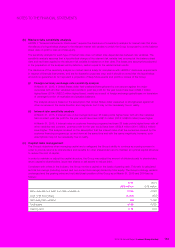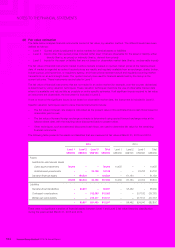Lenovo 2015 Annual Report Download - page 156
Download and view the complete annual report
Please find page 156 of the 2015 Lenovo annual report below. You can navigate through the pages in the report by either clicking on the pages listed below, or by using the keyword search tool below to find specific information within the annual report.
154 Lenovo Group Limited 2014/15 Annual Report
NOTES TO THE FINANCIAL STATEMENTS
2 SIGNIFICANT ACCOUNTING POLICIES (continued)
(k) Derivative financial instruments and hedging activities
Derivatives are initially recognized at fair value on the date a derivative contract is entered into and are subsequently re-
measured at their fair values. The method of recognizing the resulting gain or loss depends on whether the derivative
is designated as a hedging instrument, and if so, the nature of the item being hedged. The Group designates certain
derivatives as either: (i) hedges of the fair value of recognized assets or liabilities or a firm commitment (fair value hedge)
or (ii) hedges of highly probable forecast transactions (cash flow hedges).
The Group documents at the inception of the transaction the relationship between hedging instruments and hedged
items, as well as its risk management objectives and strategy for undertaking various hedging transactions. The Group
also documents its assessment, both at hedge inception and on an ongoing basis, of whether the derivatives that are
used in hedging transactions are highly effective in offsetting changes in fair values or cash flows of hedged items.
The full fair value of a hedging derivative is classified as a non-current asset or liability when the remaining maturity of
the hedged item is more than 12 months, and as a current asset or liability when the remaining maturity of the hedged
item is less than 12 months. Trading derivatives are classified as a current asset or liability.
(i) Fair value hedge
Changes in the fair value of derivatives that are designated and qualified as fair value hedges are recorded in the
income statement, together with any changes in the fair value of the hedged asset or liability that are attributable
to the hedged risk.
(ii) Cash flow hedge
The effective portion of changes in the fair value of derivatives that are designated and qualified as cash flow
hedges is recognized as other comprehensive income/expense. The gain or loss relating to the ineffective portion
is recognized immediately in the income statement.
Amounts accumulated in equity are reclassified to the income statement in the periods when the hedged item
affects profit or loss (for example, when the forecast sale or purchase that is hedged takes place). The gain or loss
relating to the effective portion of interest rate swaps hedging variable rate borrowings is recognized in the income
statement within “Finance costs”. The gain or loss relating to the ineffective portion is recognized in the income
statement within “Other operating income/(expense) – net”.
When a hedging instrument expires or is sold, or when a hedge no longer meets the criteria for hedge accounting,
any cumulative gains or losses on the hedging instrument that has been recognized as other comprehensive
income from the period when the hedge was effective shall remain separately in equity until the forecast
transaction occurs. When a forecast transaction is no longer expected to occur, the cumulative gains or losses on
the hedging instrument that has been recognized as other comprehensive income from the period when the hedge
was effective shall be reclassified from equity to the income statement immediately.
(iii) Derivatives that do not qualify for hedge accounting
Certain derivative instruments do not qualify for hedge accounting. Changes in the fair value of any derivative
instruments that do not qualify for hedge accounting are recognized immediately in the income statement.
(l) Financial guarantee contracts
Financial guarantee contracts are contracts that require the issuer to make specified payments to reimburse the holder
for a loss it incurs because a specified debtor fails to make payments when due, in accordance with the terms of a debt
instrument. Such financial guarantees are given to banks, financial institutions and other bodies on behalf of subsidiaries
or associates to secure loans, overdrafts and other banking facilities.
Financial guarantees are initially recognized in the financial statements at fair value on the date the guarantee was given.
The fair value of a financial guarantee at the time of signature is zero because all guarantees are agreed on arm’s length
terms, and the value of the premium agreed corresponds to the value of the guarantee obligation. No receivable for
the future premiums is recognized. Subsequent to initial recognition, the Group’s liabilities under such guarantees are
measured at the higher of the initial amount, less amortization of fees recognized in accordance with HKAS 18, and the
best estimate of the amount required to settle the guarantee. These estimates are determined based on experience of
similar transactions and history of past losses, supplemented by management’s judgment. The fee income earned is
recognized on a straight-line basis over the life of the guarantee. Any increase in the liability relating to guarantees is
reported in the consolidated income statement within “Other operating expense”.


